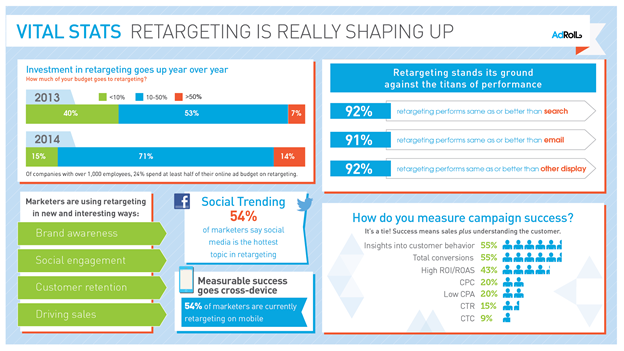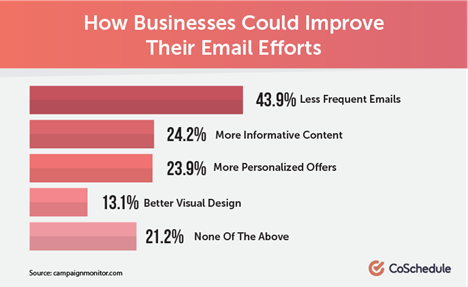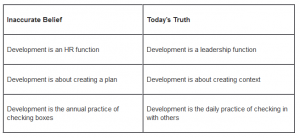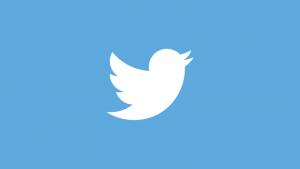Are you interested in growing your email list and boosting on-site conversation by 150%?
FYI, it’s possible. You can get this done through email retargeting (We’ll show you how later).
For now, take a look at this AdRoll survey illustration on retargeting effectiveness – Over 90% of the marketers believe email retargeting is better than search ads and other digital marketing strategies.

Those are some interesting numbers, right?
Also, 80% of business professionals and marketers believe ‘email marketing boosts customer retention.’ That explains why marketers put so much emphasis on improvising their newsletters.
Now that we’ve established the effectiveness of email retargeting, you might be wondering ‘What’s the fuss all about?’
You’ll know soon. Keep reading – I’ve got all the answers.
Let’s start with the basics:
What is Email Retargeting?
Email retargeting or email remarketing is the practice of sending emails to people on the basis of information about their interests and behavior. It’s a strategy used by marketing professionals for converting target leads into customers.
Retargeting allows marketers to send offers to prospective customers – ones who’ve previously shown interest in their brand or purchased something from the store. It is also used to send personalized pop ups based on where leads are in the sales process.
How Does Email Retargeting Work?
While you may know about businesses receiving emails and browser cookies, you may not know about how this process functions. Email retargeting works by inviting customers to interact with your brand without pushing them too much — from enticing those who have shown interest towards your product with a catching offer or special discount to offering bonus products for those who have already purchased from you.
To retarget prospective customers, marketers focus on tracking online behavior of customers. This is usually done in two different ways:
1. Pixel Retargeting: It uses unnoticeable codes and remarketing software on a website to place cookie’s on the visitor’s browser, which further tracks their online behavior.
The information gathered from these cookies lets marketers know when to send targeting emails and where to put up targeted ads for different web visitors.
2. Email Addresses: Businesses also focus on collecting user emails and have them as subscribers. They use that list to send segmented emails based on where customers are in the buyer’s journey funnel.
In this method, marketers target people whose email address they already have. After acquiring more specific information about these target customers, marketers send interest-based ads or content to their inbox to catch customer attention.
Email Retargeting Practices to Win More Customers
I’ve cultivated a list of most useful email retargeting practices for 2021.
Scroll down to see how powerful emails can be and what you can do to get the best out of them. These practices will help you keep your customers engaged, get your campaigns going, and improve your RO1 in 2021 and beyond.
1. Know Your Audience: One of the most fundamental steps to email retargeting is ‘getting to know the visitors who’ve previously interacted with your brand.’
A good understanding of your prospective customers can help you address many questions such as:
- When do your customers prefer to be communicated?
- What type of action distinguishes your target customers from the rest of the population?
- How much they’re spending per purchase?
- How frequently they’re interacting with your brand page or emails
- What are the types of email they open?
- Where are they spending money on?
- Which pages of your website they’ve looked at?
If you use tools like site tracking, you can get answers to all these questions and track your audience to understand their behavior.
Site tracking apps are powerful tools that allow marketers to create marketing processes considering behavioral targeting. You can use the collected data to segment your audience and send them triggered messages to improve conversations.
Without Site Tracking Vs. With Site Tracking:
Without Site Tracking: Visitors visit your site > they get distracted > you lose a potential customer.
With Site Tracking: Customer visit your site > they get distracted > You follow up from the left and gain a customer
2. Segment Target Customers: Another powerful email retargeting strategy is ‘segmenting customers.’ In marketing, segmentation refers to categorizing the target audience into smaller groups based on their online behavior and past interactions with the brand.
This practice helps brands focus on individuals or similar people. It helps businesses speak to people in the manner they want to be spoken. Businesses these days create segments for different groups such as:
- Customers who’ve looked at the product page but haven’t bought
- Visitors who’ve opened emails but didn’t visit the website
- Visitors who visit the site, add product to the cart, and then abandon the cart.
- Customers who bought one item but never visited again
Similarly, you can create different segments and then figure out which type of email will help you get their attention. There are hundreds of ways of segmenting email subscribers – the methods you choose will depend on your business nature and your audience.
Here’s why segmentation is important:
Without Segmentation
Marketers send same emails to everyone.
Most emails are left unseen because they are not relevant to majority of the audience.
Poor conversion rates.With Segmentation
Marketers send ‘customized’ emails on the basis what customers want to see.
Email recipients engage with the email because those emails are relevant to them.
Good conversion rates.
3. Personalize Your Emails: You must have heard of this tactic earlier too – because personalization isn’t a new strategy. But it keeps picking up the steam and never fails. Brands use this strategy to:
- Boost ROI
- Create relevant content
- Improve engagement
- Meets subscriber’s expectation
- Increase sender reputation
- Motivates users to share personal data
- Boost open rates
Please remember that personalization today is not limited to using ‘first name’ of the email recipient. There’s more to personalized emails than you think.
Look at how you can personalize your emails and make them appear different:
- Use personalized imagery
- Write subject line that evoke personal curiosity
- Add an emotional payload to your emails
- Use lead-in content
- Create a sense of urgency using a deadline
- Personalization: first name
- Use the name of consultant who they worked with in the past
In short, try to focus on customer behavior wherever you can.
4. Nail out the Timing & Frequency: As a marketer, it is important for you to find the perfect time to send emails to your target audience. Here’s also, you’ll need to keep ‘customer behavior, segmentation, and personalization’ in mind and figure out the best timing for your audience.
We’ve also learnt that it’s better to send emails on ‘off times.’ For example, try sending your newsletters at 08:17 PM instead of sending them at 08:10 PM. Sending emails at the top hour increases the chance of getting customer attention because they’ll most probably be getting multiple emails during that time.
Nailing down perfect timing is tough for all types of companies. But there are few basic truths that stay true. We’ve got you results from a DMA survey on ‘when should brands send emails.’
The answer depends on your nature of business, to look:
- 18% (B2B), 3% (B2C): Once Per Month
- 37% for both B2B and B2C: 2-3 Times Per Month
- 25% (B2B), 30% (B2C): 4-5 Times Per Month
- 7% (B2B), 11% (B2C): 6-8 Times Per Month
- 5% (B2B), 14% (B2C): More Than 8 Times Per Month
If we go by this, the ideal frequency would be 3-4 times per month, i.e., one email per week. From this data, we can sketch out a rough guideline for both B2B and B2C businesses:
- B2C: Bi-weekly to weekly emails. 67% of B2C companies send email 2-5 times per month.
- B2B: No more than five emails per month. Brands should focus on tweaking their approach and adjusting according to results.
5. Quality > Quantity: While you’re writing email content, please remember that quality beats quantity. Email retargeting is surely important but that doesn’t mean you flood your subscriber’s inbox with hundreds of emails every week.
In fact, that’ll do you worse than good. If these recipients feel overwhelmed with the number of emails they receive, they may simply unsubscribe or mark your email address as spam.
Look at this Campaign Monitor survey result on ‘how businesses can improve their email efforts.’ To enhance quality, you need to send less frequent emails, share more relative content with personalized offers and better visual design.

Always keep in mind that customers these days are overwhelmed with information overload. Sending lesser (but effective) emails can potentially improve results. Hence, try to focus on quality instead of quantity. The emails need to be engaging and unique – only that will get your clicks.
6. Keep Email Designs Consistent: Did you know that consistent branding can increase revenue by as much as 33%?
Here’s another tip you can keep in mind to improve quality of email – keep your email designs consistent with your brand image. Branding goes beyond a typeface and logo. It’s your essence, ethos, and story.
Whether you’re using a pre-designed template, or you’ve hired a personal designer or developer to code your emails, make sure to align email content with your brand image.
Your email content should instantly remind the audience about your brand. At first, it may seem challenging to keep a brand’s feel and look consistent. But, eventually, this practice will pay off.
Few tips to keep in mind:
- Establish a Style Guide
- Build Templates to Match Your Campaigns
- Secure Templates of different kinds: Newsletters, promotional emails, transactional emails, privacy updates, and automated emails
7. A/B Test Your Emails: When it comes to email marketing, email retargeting or any marketing technique for that matter, there’s no ‘one-size-fits-all’ solution. So, experimenting and re-testing different methods is a ‘must-do.’
I’d suggest A/B testing every part of your email – whether that be the subject line or the CTA of the email. A/B testing will help you figure out what’s working and what’s not. So, do not skip it.
Few tips to keep in mind:
- Test one element at a time
- Always have a significant sample size in your testing
- Always send emails at same time
If you want to learn more about A/B testing your emails, here’s a guide that can help you ace this step (add link).
Statistics that’ll Convince You to Consider Email Remarketing:
As promised, here are some stats and proofs to convince you this isn’t just us saying email retargeting is the best marketing investment you’ll ever make:
- Email Retargeting can increase conversion rates by almost 150%.
- 90% of marketers believe retargeted ads perform better than other digital marketing avenues.
- Retargeted audiences are 70% more likely to convert in comparison to visitors who aren’t targeted for the second time.
- 49% of brands and 68% of agencies relocate their budgets to retargeting.
- 46% of online marketers believe retargeting is the most underused online marketing tactic.
These statistics show us the importance of email retargeting in converting visitors into customers. Put simply, you cannot overlook its importance. Hence, it is necessary to keep best practices in mind for the maximum benefit.
Take the Next Step
There you have it! The email retargeting best practices, broken down.
Well, the bottom line is ‘Email retargeting is more important than you think.’ However, it isn’t as difficult as it seems initially. In fact, if you understand how retargeting works, and remain consistent at following email retargeting best practices, you’ll feel the difference within a few weeks.
As you see, email retargeting is all about knowing your audience, segmenting them properly, and utilizing tailored offers to attract their attention. Skipping on these basic steps will prove to be a waste of resources and put you behind your competition.
So, without further ado, take the next step, and start working on your emails.
Digital & Social Articles on Business 2 Community
(23)





